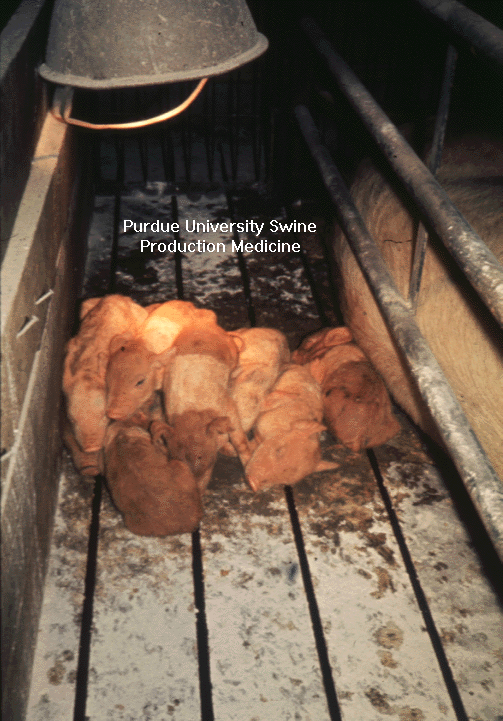
Purdue Pork Page Archive
This material is for informational purposes only. You cannot definitively diagnose the cause of diarrhea just by looking at affected pigs. Please consult your veterinarian for a diagnosis and proper treatment
Neonatal Diarrhea 
| 0-5 day old pigs | Clostridium perfringens | Strongyloides ransomi | ||
|---|---|---|---|---|
| 5-21 day old pigs | Coccidiosis |
The age of the pig can be used to help diagnose the cause of neonatal diarrhea, since many diseases are more or less likely to occur when the pig is a certain age. Remember that these ages in many cases are not absolutes, but guidelines to help us sort out the various causes.
The four causes we are most likely to find in this age pig are E.coli, Transmittable Gastroenteritis (TGE), Clostridium perfringens Type C, and Strongyloides ransomi.
Signs: Fluid, yellow, watery diarrhea, reddened rear ends, mucus in stools, and dirty feet.
Will often see in pigs less than 72 hours old
Necropsy: Fluid content in the intestine, dilated stomach with undigested milk present.
Treatment: Consult your veterinarian.
Prevention:
Signs: Diarrhea and vomiting in all ages of pigs, gilts and sometimes sows, yellow, watery diarrhea in baby pigs, sudden onset,
high mortality, decreasing mortality with age.
Occurs most commonly in the winter.
Necropsy: Fluid content in the small intestine, thinning of bowel wall.
Treatment: Consult your veterinarian.
Prevention: Maximize biosecurity especially in the winter.
3. Clostridum perfringens Type C
Signs: Reddish-brown, bloody to non-bloody diarrhea, grey necrotic debris in feces, wasting and death.
Necropsy: Intestine filled with a dark bloody fluid and necrotic debris.
Treatment: Consult your veterinarian.
Prevention:
Signs: Yellow diarrhea starting in pigs 72 or more hours after birth. Occurs most commonly in warm climates.
Necropsy: Fluid content in the intestine with undigested milk present.
Treatment: Consult your veterinarian.
Prevention:
All of the above can occur in 5-21 day old pigs along with Rotavirus, Coccidia, Milk Scours.
Signs: Similar to TGE except that this will be a milder disease. The number of pigs sick and dying will be less and the sows will not be as sick.
Necropsy: Similar to TGE.
Treatment: Consult your veterinarian
Prevention: Consult your veterinarian
Signs: Yellow to yellow-brown diarrhea starting at 7-10 days. Weight loss and stunting common.
Necropsy: Necrotic debris will often be found in the intestine.
Treatment: Consult your veterinarian.
Prevention:
Signs: White scours in 14-21 day old pigs that are healthy and doing well.
Prevention:
Purdue Pork Page Archive